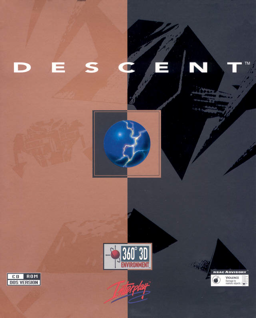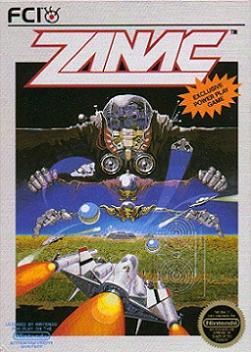
Asteroids is a multidirectional shooter video game developed and published by Atari for arcades. It was designed by Lyle Rains and Ed Logg. The player controls a single spaceship in an asteroid field which is periodically traversed by flying saucers. The object of the game is to shoot and destroy the asteroids and saucers, while not colliding with either, or being hit by the saucers' counter-fire. The game becomes harder as the number of asteroids increases.

Quake II is a 1997 first-person shooter video game developed by id Software and published by Activision. It is the second installment of the Quake series, following Quake.

Descent is a first-person shooter (FPS) game developed by Parallax Software and released by Interplay Productions in 1995 for MS-DOS, and later for Macintosh, PlayStation, and RISC OS. It popularized a subgenre of FPS games employing six degrees of freedom and was the first FPS to feature entirely true-3D graphics. The player is cast as a mercenary hired to eliminate the threat of a mysterious extraterrestrial computer virus infecting off-world mining robots. In a series of mines throughout the Solar System, the protagonist pilots a spaceship and must locate and destroy the mine's power reactor and escape before being caught in the mine's self-destruction, defeating opposing robots along the way. Players can play online and compete in either deathmatches or cooperate to take on the robots.
An action game is a video game genre that emphasizes physical challenges, including hand–eye coordination and reaction time. The genre includes a large variety of sub-genres, such as fighting games, beat 'em ups, shooter games, rhythm games and platform games. Multiplayer online battle arena and some real-time strategy games are also considered action games.

SubSpace is a 2D space shooter video game created in 1995 and released in 1997 by Virgin Interactive which was a finalist for the Academy of Interactive Arts & Sciences Online Game of the Year Award in 1998. SubSpace incorporates quasi-realistic zero-friction physics into a massively multiplayer online game.

Star Trek: Away Team is an isometric real-time tactics video game developed by Reflexive Entertainment and published by Activision. The game was initially released in March 2001 for personal computers using Microsoft Windows in North America. The game is set in the Star Trek universe, after the end of the Dominion War seen in the television series Star Trek: Deep Space Nine. It features a range of new characters, set on board the USS Incursion with voice appearances by Brent Spiner and Michael Dorn as Lieutenant Commander Data and Ambassador Worf, respectively. The game received mixed reviews, with criticism directed at the graphics, elements of the gameplay including the lack of any artificial intelligence, and the limited length of the game.

Zanac (ザナック) is a shoot 'em up video game developed by Compile and published in Japan by Pony Canyon and in North America by FCI. It was released for the MSX computer, the Family Computer Disk System, the Nintendo Entertainment System, and for the Virtual Console. It was reworked for the MSX2 computer as Zanac EX and for the PlayStation as Zanac X Zanac. Players fly a lone starfighter, dubbed the AFX-6502 Zanac, through twelve levels; their goal is to destroy the System—a part-organic, part-mechanical entity bent on destroying mankind.

Buck Bumble is a 1998 third-person shooter game for the Nintendo 64 developed by British video game company Argonaut Software and released by Ubi Soft. A special Buck Bumble rumble pack was packaged with the U.K. version.

Addiction Pinball is a pinball video game developed by Team17 and published by MicroProse for Microsoft Windows in 1998. It features tables based on two Team17 games, World Rally Fever and Worms.

Plane Crazy is an airplane combat/racing video game for Microsoft Windows and Sony PlayStation in which contesting pilots race planes through 3D courses. Plane Crazy was based around arcade racers rather than flight simulation, focusing on action rather than realism. It was originally planned for release in arcades as one of the first games to use Microsoft and Intel's Windows-based arcade system. The game supported the Heat.net (Windows) and Multiplay (PlayStation) multiplayer gaming system, with up to eight players allowed in one race.

Chicken Invaders is a series of shoot 'em up video games created by Greek indie developer Konstantinos Prouskas. With the release of the first game Chicken Invaders in 1999, the games are one of the longest running series of video games developed in Greece. All six main entries in the series have been developed by Prouskas' InterAction studios, and have been released for Microsoft Windows, OS X, Linux, iOS, Windows Phone, and Android platforms.

Gyrostarr is a shoot 'em up video game developed and published by High Voltage Software. It is one of several video games released only as WiiWare through the Wii Shop Channel, because of this, the game is no longer purchasable due to the shutdown of the Wii Shop Channel. It was released in North America on June 23, 2008.

Total Eclipse is a space flight simulation video game developed and published by Crystal Dynamics for 3DO. It was later ported to the PlayStation under the title Total Eclipse Turbo. The game was copyrighted in 1993 and released 1994. Total Eclipse Turbo was a launch title for the PlayStation in the U.S., with the game's released date predating the North American console launch by 11 days. A sequel, Solar Eclipse, was released for Sega Saturn and PlayStation.

Warlords III: Reign of Heroes is a computer wargame released in 1997, and the third release in the Warlords video game series. In 1998 it was followed by the expansion Warlords III: Darklords Rising.

Diablo is an action role-playing video game developed by Blizzard North and released by Blizzard Entertainment in January 1997, and is the first installment in the video game series of the same name.

Sinistar: Unleashed is a 1999 action space shooter video game for Microsoft Windows. It was designed by Marc Michalik and Walter Wright and developed at GameFX, a small studio composed of former members of Looking Glass Studios. Originally titled Out of the Void, development of the project began in 1997 and had no relationship with the Sinistar franchise. After licensing the franchise from Midway Games that year, GameFX shifted the focus of the game and developed it as a sequel to the original Sinistar, which was released by Williams in 1982.

"GENETOS" is a freeware vertical shooter game or "shoot 'em up" developed and published by Tatsuya Koyama with an "evolution" theme. In GENETOS, the levels represent different generations in the evolution of shooting games.

Crimsonland is a top-down dual stick arena shooter video game with role-playing elements. It was developed by Finnish studio 10tons Entertainment and published by Reflexive Entertainment in 2003. In 2014 a re-release through digital distribution followed.

Uprising: Join or Die, also known as simply Uprising, is an action real-time strategy video game by American developer Cyclone Studios, released in North America on October 14, 1997 and in Japan on July 24, 1998 for Windows. The player controls a powerful combat vehicle known as the Wraith that transports rebel units onto the battlefield, fighting against the military. For the first few months of its development, it had no script written for it and as the release date neared, gameplay videos were created to demonstrate its support for the 3dfx graphics card. It received a port to the PlayStation as Uprising X, which was released in December 1998; and before that, a sequel, Uprising 2: Lead and Destroy, was released for the PC on December 9, 1998.
















